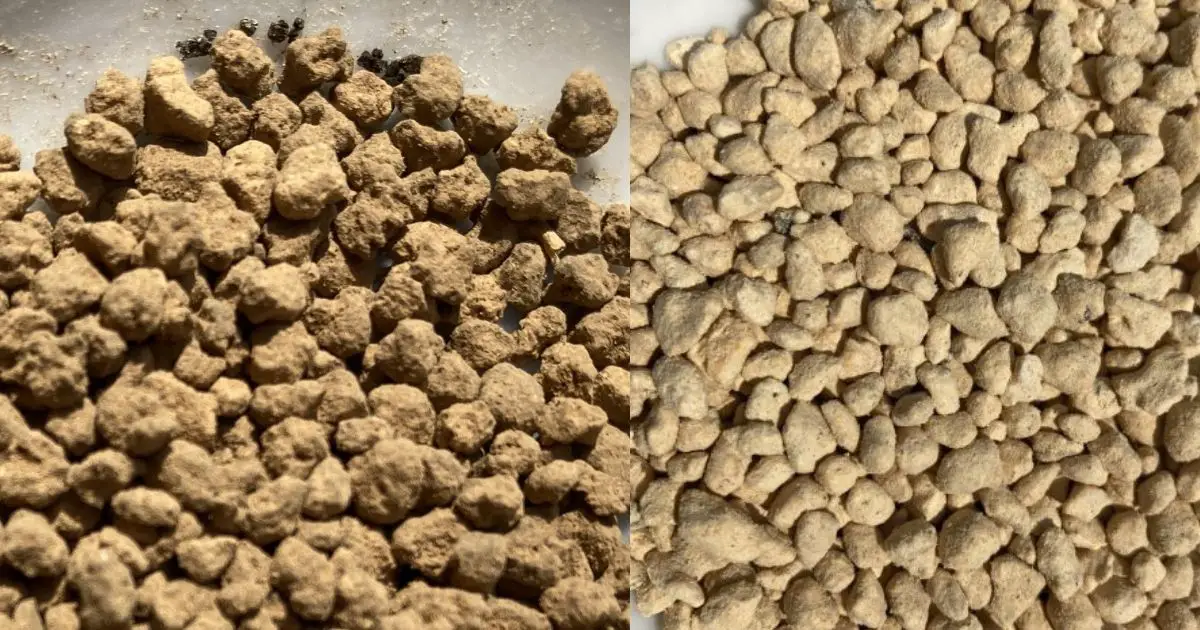One of the fundamental aspects of successful bonsai care is choosing the right soil mix. Good bonsai soil requires the perfect balance of water retention, drainage, and aeration. It also needs to be slightly acidic and low in nutrients.
Understanding Bonsai Soil
What makes bonsai soil different?
Bonsai soil is not your typical garden soil. It is a specialized medium designed to meet the unique needs of bonsai trees. Good bonsai soil requires the perfect balance of the following;
-
- Good water retention,
- Good drainage,
- Good aeration,
- Adequate soil pH (slightly acidic), and
- Low in nutrients.
These characteristics are crucial for bonsai trees because they are confined to small pots, and their roots need an environment that maximizes water and nutrient uptake while preventing root rot.
Water retention
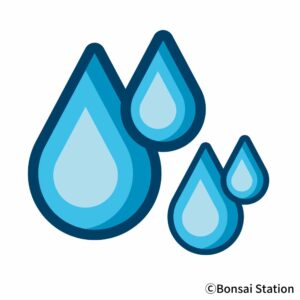
Bonsai soil should retain enough water to keep the tree hydrated for the process of photosynthesis, during which trees use hydrogen from water absorbed through the roots to produce energy.
Drainage/ aeration
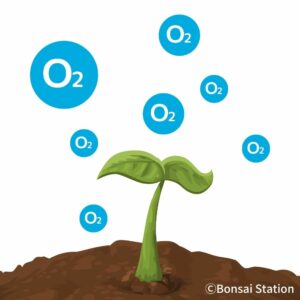
Efficient drainage and aeration ensure that excess water escapes the pot quickly and the roots breathe oxygen. Oxygen is essential for the roots’ metabolic processes that support nutrient uptake and cell repair. Adequate oxygen levels in the root zone are crucial for healthy growth.
This is especially important for bonsai trees because they are grown in small, shallow pots, which restrict the amount of space available for the roots. Excess moisture can accumulate quickly in such a confined space, in addition to the fact that bonsai pots can’t drain water well because gravity doesn’t work when there isn’t depth.
pH
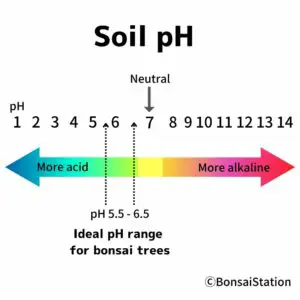
Soil pH & bonsai tree
The pH level of the soil influences nutrient availability to the bonsai tree’s roots. Different species of bonsai trees may have varying pH preferences, but generally, a slightly acidic soil (between 5.5 to 6.5) is suitable for most traditional bonsai.
Nutrient holding capacity
Bonsai soil mixes should retain nutrients well to support the tree’s growth whenever they are given. It is important to control the tree growth to have an ideal shape and style of the tree by giving or cutting nutrients to your trees.
To dive into the importance of these factors to bonsai soil, please check the following post.
Components of the best bonsai soil mix
Creating a perfect bonsai soil mix to attain good water retention, drainage, aeration, adequate soil pH (slightly acidic), and good nutrient-holding capacity involves a delicate balance of components.
The following soils are the backbone of bonsai soil, providing these characteristics.
-
- Akadama/ lava rock,
- Pumice, and
- Organic matter/compost.
Akadama
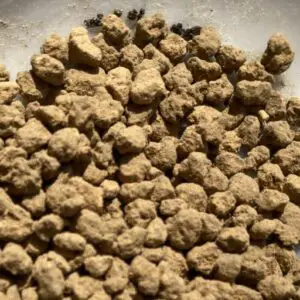
Akadama
Akadama is a volcanic ash from Japan known for its ability to retain moisture while still allowing for adequate drainage and aeration. It is slightly acidic and can hold onto nutrients very well, which makes Akadama a perfect ingredient for bonsai soil.
Lava rock
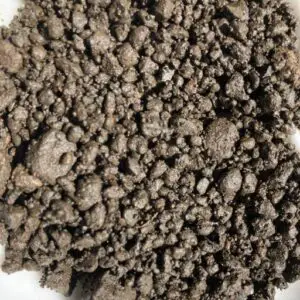
Volcanic rock
Lava rocks are formed from lava erupted from a volcano, which, in general, has good aeration and drainage. But its water-holding and nutrient-holding capacities depend on where it comes from.
Lava rocks are a good alternative for Akadama.
Pumice
Pumice is a lightweight volcanic rock that contributes to both aeration and drainage. For downside, pumice has low water-holding and nutrient-holding capacity, which is a major drawback as bonsai soil.
Organic matter/compost
Composted pine bark or humus is rich in nutrients and retains moisture while having adequate drainage. Bonsai soil should not contain a high percentage of organic matter to control trees’ growth; give nutrients when we want them to grow.
Particle size matters
One of the critical aspects of bonsai soil is the particle size of its components. Different tree species in different conditions have varying root structures and moisture requirements, which means you need to select the right particle size for your bonsai mix.
Here’s a general guideline on the particle size based on the tree size.
| Bonsai size | Particle size |
| Large (<24 in/ 60cm) | 1/8″ – 1/4″ in (3-6 mm) |
| Medium (8-24in/ 20-60cm) | 1/16″ – 1/8″ in (2-3 mm) |
| Small (>8 in/ 20cm) | 1/16″ in (1-2 mm) |
| Mini | 1mm |
Best bonsai soil mix to buy
There are many bonsai soil mixes in the market but not all of them are actually suitable for growing bonsai. They tend to blend too much organic matter which makes the soil too wet for bonsai trees. The particle size may vary within the soil mix or you don’t know if the soil pH is good for bonsai trees.
In this regard, I think “Bonsai Soil” by Bonsai Supply is the best all-purpose bonsai soil mix you can buy at a reasonable price.
Regular size trees
(For trees more than 6 inches tall)
This soil is a mixture of pumice, lava rock, calcined clay (like Akadama) and pine bark, which are the components for the best bonsai soil mix as I mentioned earlier. This perfect mix ensures ideal drainage, water retention, nutrient uptake, and aeration. The soil is slightly acidic, with pH of 6.21, which is also perfect for bonsai trees.
Mini bonsai trees (Shohin bonsai)
(For trees less than 6 inches tall)
If you have smaller bonsai trees with a height of less than 6 inches, there is small grain soil good for mini bonsai trees in this product line as well. Smaller particles provide a good foundation for the trees’ fine root structure and water retention.
Tailoring premixed bonsai soil
Each tree species has unique requirements for soil composition, drainage, and moisture retention. While there are excellent premixed bonsai soils available that cater to a wide range of species, you might find yourself wondering how to make these prepackaged blends perfectly suit your bonsai’s needs.
Fortunately, with a bit of knowledge and customization, you can tailor a premixed bonsai soil mix to create the ideal growing environment for your miniature trees.
Step 1: Know the environment and your tree’s preferences
Begin by familiarizing yourself with your bonsai tree’s specific preferences. Different bonsai species have varying preferences when it comes to soil. Here’s a general guideline.
Species
Conifers
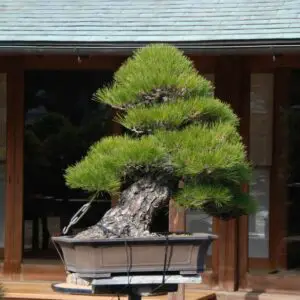
Japanese black pine
Conifers generally prefer soil mixes with good drainage. A mix with a higher proportion of inorganic components like pumice and lava rock works well.
Deciduous trees
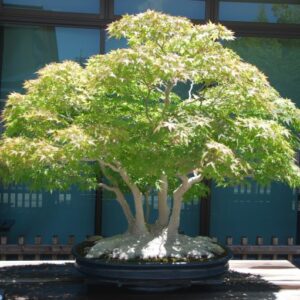
Deciduous trees normally love water and may fit in a more moist condition. You can use a balanced mix with a bit of emphasis on Akadama/ calcined clay or organic matter for water retention.
Flowering/fruiting trees

Azalea bonsai
Flowering/fruiting trees need lots of nutrients for blooming. The soil should provide nutrients like organic matter or pine bark to hold nutrients to support robust bloom and fruit production.
Climate
The climate also plays an important role in customizing premixed soil.
In dry and arid regions where moisture evaporates quickly, increase Akadama/ clayish components or organic matter in your mix. In areas with high humidity, on the other hand, increase pumice to focus on more drainage to prevent waterlogging.
Step 2: Examine the premixed soil
Take a close look at the premixed bonsai soil you have on hand. Most commercial bonsai soil mixes typically contain a combination of components such as Akadama, pumice, lava rock, and organic matter.
Pay attention to the proportions of these components in the mix. The proportion may change water retention and drainage drastically.
Step 3: Adjust the mix to fit your tree
Now comes the fun part – tailoring the soil mix to align with your tree’s unique requirements. Here’s how you can customize it.
Coniferous trees
If your tree thrives in well-draining soil, consider adding more pumice or lava rock to the mix. This will reduce the proportion of components that retain moisture, like organic matter or Akadama.
Deciduous trees
If your tree prefers a slightly moister environment like deciduous bonsai trees, you might want to add more clay to hold water. Be careful not to add too much of it. Calcined clay will help retain moisture, but you should also avoid waterlogging your trees.
Remember that excess drainage can be fixed by simply giving water more often or putting moss over the soil but soil mix that holds too much water cannot be corrected unless you change the soil completely.
Flowering and fruiting trees
For flowering and fruiting bonsai trees that need abundant nutrients for blooming, you might want to add more bark to hold nutrients or compost to the soil. Avoid adding too much organic matter as it may make the soil too wet for bonsai trees.
Step 4: Start slow and monitor
Repot your bonsai tree using the tailored soil mix you’ve created.
You should start by adding these soil amendments a little less than you think needed the first time. Check how your trees are doing regularly to see if the new soil mix is meeting their needs and make changes next time, if necessary.
If you are ready to mix your own bonsai soil from scratch and interested in how to do it, here’s what you need to know.
Vital role of fertilization
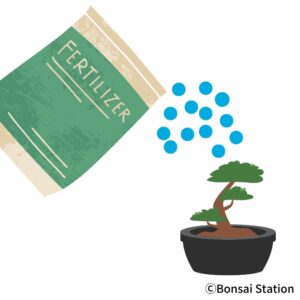
While premixed bonsai soils are carefully formulated to provide the right balance of water retention, drainage and aeration, they generally lack one critical element: nutrients. This lack of nutrients is by design but your bonsai trees need nutrients to thrive.
This is where regular fertilization comes into play. Fertilizers provide your bonsai trees with the essential nutrients they need to thrive in an ideal bonsai soil mix that lacks nutrients. They are vital for overall growth, foliage development, root health, and the critical processes of flowering and fruiting in certain bonsai species.
When choosing a fertilizer for your bonsai trees, it’s important to consider the nutrient content, species-specific requirements, fertilizer type/form/origin, and budget. Select slow-release, solid fertilizer with a higher proportion of nitrogen (NKP ratio of 2-1-1 or 4-2-1).
If you want to know which products are the best, please check the following article.

